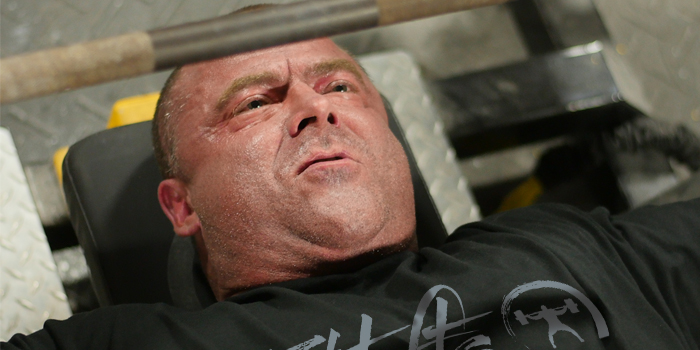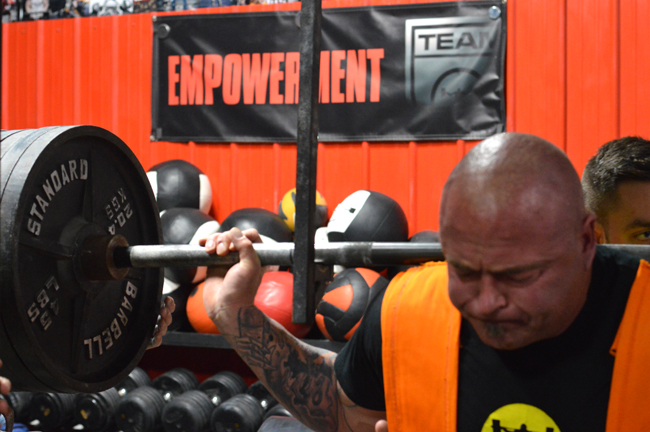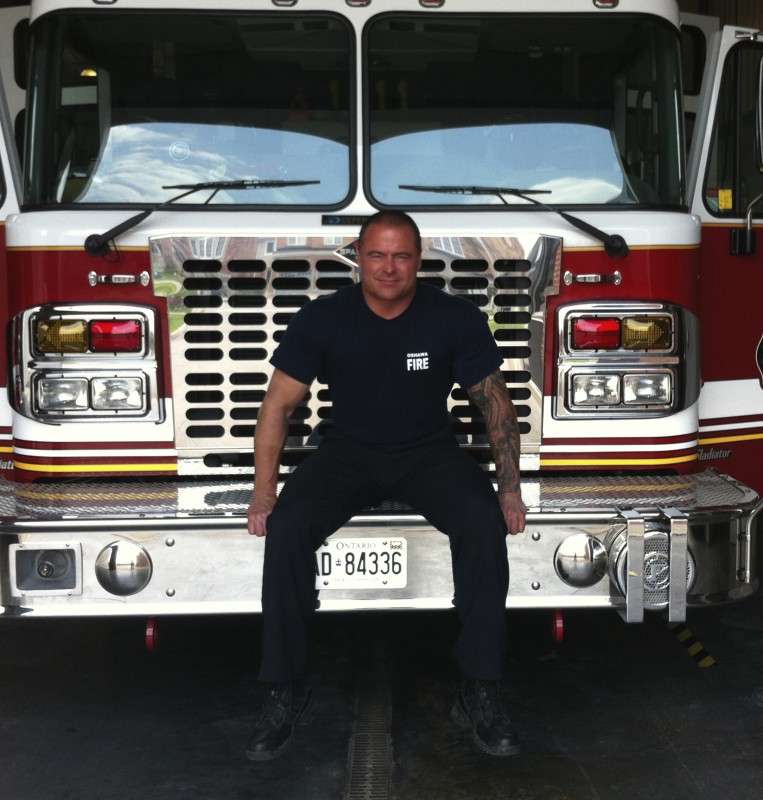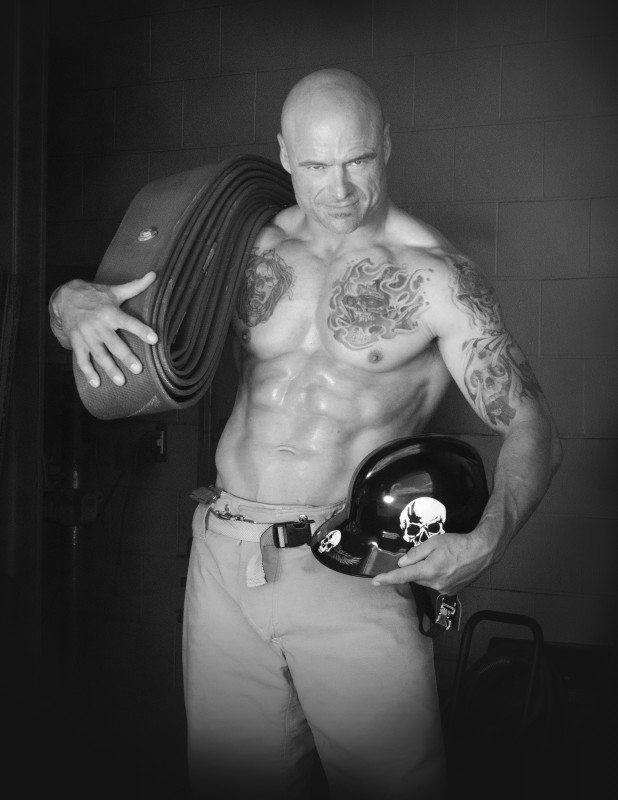
I’ll be the first to admit that I’m not a nutritionist or dietician. But I am definitely an information junkie when it comes to nutrition and the science behind how your body responds to changes in food. I will also admit that I am a simple dude. I like to keep my training and nutrition as simple and as effective as possible. I consider food nothing more than fuel.
In the past, I’ve tried numerous diets in an attempt to get muscular and lean and still have energy to strength train. One thing that I believe is important for anyone trying to achieve a degree of leanness is to have a goal that holds him or her accountable for their body composition change. There are always people trying to lose ten or twenty pounds to get ready for the trip south, a wedding or some other short term event that really doesn’t hold the same accountability as getting ready for a photo shoot, a bodybuilding or figure competition, or perhaps a firefighter calendar.
Two years ago, our department association was looking for volunteers to participate in a firefighter calendar shoot that would be sold to raise money and support a local children’s charity. Even though I was 48, I still considered this to be an opportunity to see if I had the metal to take on this challenge and come out looking a little better than Homer Simpson’s dad.
Like I said before, I am a very simple dude and after having had a taste of measuring macronutrient ratios and weighing food in the past, I vowed not to become a food nazi, robot or carry a small fridge on my back with an alarm that rings every two hours to signal it was time to feed the animal. I have been a big proponent of intermittent fasting and it works for me, very well.

My guidelines that I follow are structured more around how the body's hormones function. In the morning, when cortisol levels are high and your body is in prime fat burning mode after fasting all night, I either skip breakfast all together or I will have a small protein/fat breakfast,. (i.e. whole eggs or shake with avocado/egg whites/natural nut butters or a sausage).
Most of the time I didn’t eat until at least noon. I kept my daily eating window from noon until 8:00 pm, which usually consisted of three to four meals with limiting carbohydrate intake until the last meal of the day to replenish glycogen stores. On non-training days I skipped the carbohydrates at night and only utilized them post-workout or on the evenings I trained.
Most dieting protocols for bodybuilding or figure competitors can consist of twelve, sixteen or twenty weeks of strict dieting. Remember: Simple Dude. I gave myself six weeks to get ready for this challenge.
My simple plan: I was going to continue following the basic template that I was using by intermittent fasting with three to four meals in an eight-hour feeding window. The difference I implemented was simple. I limited carbohydrate intake for all three or four nightly meals and planned a re-feed night every Sunday and Thursday night.
The first two weeks of the new protocol worked really well. Most of the protein I was eating was red meat so I had lots of energy with the extra fat intake. Four weeks out I changed my protein intake to primarily white meat (chicken, whitefish, tilapia, tuna). Almost immediately, I could feel the difference in energy due to changing my protein sources. I was more tired, but it definitely worked to help me get leaner.

Four weeks out I also added the dreaded cardio component. Four times a week I alternated HIIT sprints on the treadmill for a least eight to ten rounds (20 seconds on/40 seconds off) with a five minute warm-up and five minute cool down. HIIT training was alternated with a steady-state cardio session lasting 40 minutes, usually a fast paced walk at an incline of twelve to fifteen degrees.
One thing that was apparent to me is that your body does NOT want to get rid of any weight. This is an evolutionary survival system that wants to store fat to keep you alive. Get rid of your fat reserves and your chances of survival in the natural wilderness are reduced.
This was very apparent because I was diligent about weighing myself every morning during this preparation. My weight would stay exactly the same for about three to four days and then one morning it would drop three or four pounds. This cycle repeated for the entire prep and I concluded my body was trying to hold on, and hold on as long as possible. My body was reluctant to drop weight until it was forced to finally give up and drop a few pounds.
The last week leading up to the photo shoot I did the dreaded water load, drinking over two gallons a day for four days to activate my aldosterone hormone which regulates levels of sodium and potassium, and blood pressure and volume. During water load, food intake consisted of mostly protein only as one gram of carbohydrates holds three grams of water and your goal is to get rid of water. Hormones always respond to a reverse feedback loop so when your body is taking in too much water, aldosterone tells your body to get rid of excess water which results in you going to pee about 50 times a day. Catheter, anyone?
Twenty-four hours prior to the photo-shoot I stopped drinking water altogether but the aldosterone still believes you’ll continue to have a high water intake so it continues to regulate homeostasis by getting rid of water. You trick your body into doing this…very cool.
The night before the photo-shoot I started eating carbohydrates (if you remember carbs store water) so when you add carbohydrates the last day it draws any residual water from under your skin into your muscle that gives you a fuller, leaner, more pumped up look.
When I started the calendar prep I weighed almost 250 pounds. The morning of the photo shoot, I weighed 238 pounds.
I’m glad I had the opportunity to challenge myself to see if I had the mental toughness to go through with this experiment. I highly recommend you give it a try sometime. I kept my plan simple so I didn’t have to carry trays of Tupperware everywhere I went and I didn’t count macronutrients or weigh any food. It was a good experience but I’m glad I won’t be doing it again! If I can commit to a challenge like this at 48 years old, you can do it too!
I have developed a new appreciation for bodybuilders, figure athletes and anyone who does this on a regular basis as part of competition. The dedication and commitment needed to get into that type of body composition is nothing short of monumental. My hats off to you all.
For now, I like being a bloated-up powerlifter who still eats clean but doesn’t have to worry about trying to achieve single digit body fat. Besides, I’m so old that my next calendar would probably show me sitting in a wheelchair in pajamas covered with a wool blanket, hooked up to an IV, sitting beside the flower garden at the rest home for seniors.










Were they just a moderate opening up of the carbs or were they Epic Oreo-downing blow-outs? (http://asp.elitefts.net/qa/training-logs.asp?qid=115451)
My re-feeds were usually "dirty" in nature... a few pieces of pizza, BIG BOY burgers or an "All You Can Eat Sushi night"... I usually mixed up some simple and complex carbs but never counted anything. The last re-feed night we went out and I stuffed myself on Sushi and then stopped on the way home and got a bucket of ice cream (I went "all out")... next morning I was 4 lbs lighter.... Crazy!
-Do you have any shirtless pics from the start and again from a week out (before hydration period)? I'm curious how far I am from your starting point and also what kind of difference the water makes. I may need more than 6 weeks.
-Did you change anything in your lifting template?
Bethany: After switching from red meats to white meats I could tell my energy levels were decreased but I setup my carb re-feeds on Sunday night and Thursday to help out with training because at that time I was training a four day split Mon/Tues & Thurs/Fri which really helped me feel better... believe me I looked forward to both of those nights so I could remain more functional.
Brian, thanks for the comment. I didn't take any pictures to compare before or after shots (in retrospect I should have) The water load/depletion makes a big difference aesthetically but it is temporary. Everything becomes more pronounced and veiny... I was most impressed seeing multiple veins in my quads! My training template didn't change at that time.... I was competing in the Firefighter Combat Challenge and was doing a 4 day split each week which was primarily compound movements.. squats/rows/deadlifts/Military Presses & Dips and I had the odd day of skill work with our team either running stairs, pulling rope, dragging sleds etc. I wasn't fat to start with: I was over 250 lbs at the time and now I'm hovering between 275 to 280! Isn't powerlifting awesome!
Inspiring Article! I am a Firefighter as well and have been asked several times to do a similar calendar. This article is a great jumping off point to start from, but do you have any other resources I could use?
I am 6'1 208lbs, but probably around 20% bf. I workout consistently, but there is no consistency in the workouts. -- For example a week's workout regimin may look like: crossfit type (multistation various excercise) workout one day, heavy deadlifts another day, Bi's, Tri's, Abs on another day. Of course I try to hit a bodypart I havent done in few days and try to maintain some sort of baseline strength in the big 3, but otherwise I'm all over the place. I feel like it helps me stay well rounded for the unknowns we may face day to day. I do realize though that I never can make any huge strength gains this way, but for now I am ok with that.
...But, I do know my diet is crap. Inconsistent etc. Again, any guidance or pearls of wisdom you could offer would be greatly appreciated!
Thanks,
Tom
BSFD FF, Paramedic
Jimmy: I always like training in the morning if possible while fasted, however I always followed morning training with a PWO carb shake usually consisting of protein/berries and a banana or two. This didn't seem to affect the ability to lose bodyfat. Training time and sleep time didn't change my plan for my feeding window, it was always noon to 8:00 pm whether I was working a dayshift or nightshift... it was simple for me that way and your body responds to the circadium rhythm of daytime/nighttime whether your working or not... I always tried to follow the path of how your hormones function.
James: Training time never affected my feeding window. I always preferred to train in the morning but obviously working some dayshifts shifted my training later in the day which usually fell into my feeding window anyway. My opinion is you can train whenever its convenient for you and your work schedule and still be able to follow the main principles of how I outlined my plan. Train during the morning = PWO carb shake. Train later in the day = PWO carb shake which fell into your feeding window. Everyone's schedule is different, you have to find something that works for you.
Tom: Hello fellow Firefighter! I would highly recommend commiting to a calendar, that will ensure you have a target goal to work towards.... if I didn't have the calendar commitement, I doubt I would have followed through with the project. My resources I used when I first found this type of nutritional protocols were Martin Berkhan who has a website called Lean Gains. I also got the Carb Nite ebook and Carb Backloading ebook from John Kiefer who has a website. John Kiefer's books are great at explaining the science behind how your hormones work and function and why you need to follow the guidelines. Ori Hoffmekler also wrote the Warrior Diet which is another system similar to Intermittent Fasting but he allows undereating during the day and larger meals at night. When you start reading these books, you'll see a similar pattern how your body functions and when it requires the appropriate fuel. I know a lot of people who measure every piece of protein/carbs & fat that goes into their body and that's great if they can sustain dieting that way, however like I explained I am a very simple dude and this style of eating is very simple, effective and easy to maintain for me. I still don't eat breakfast and presently I follow a similar style of eating... but I'm not trying to get lean, I just want to get stronger so my protein sources are mostly red meat for the extra fat and energy.
Hope these explanations help everyone. Once again Thanks a Ton for all the feedback!
Ken
Just wondering, with your weight training, what sort of intensity and sets x reps were you working at during the 6 weeks? As I've always believed that lower volume strength training with compounds is priority when getting lean in order to maintain as much muscle as possible, as opposed to performing higher rep and high stress /hypertrophy type work...just wondering what worked for you?
Thanks!!